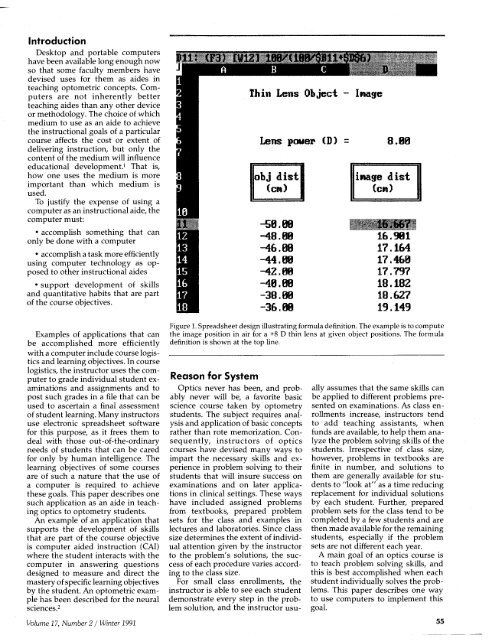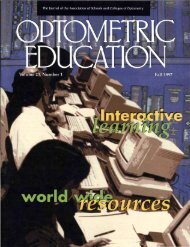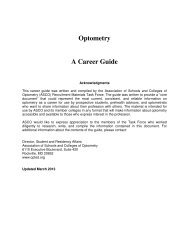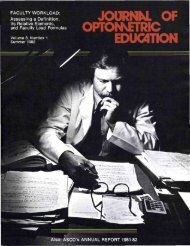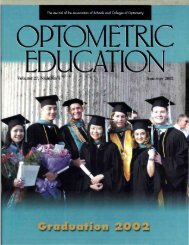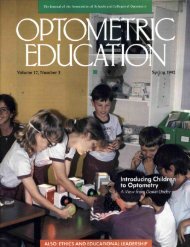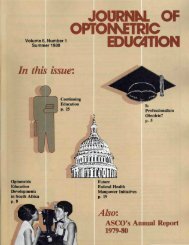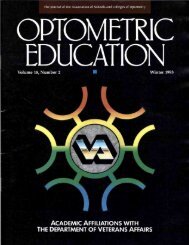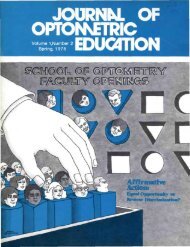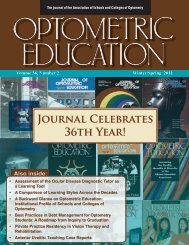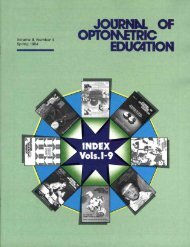Winter 1992, Volume 17, Number 2 - Association of Schools and ...
Winter 1992, Volume 17, Number 2 - Association of Schools and ...
Winter 1992, Volume 17, Number 2 - Association of Schools and ...
Create successful ePaper yourself
Turn your PDF publications into a flip-book with our unique Google optimized e-Paper software.
Introduction<br />
Desktop <strong>and</strong> portable computers<br />
have been available long enough now<br />
so that some faculty members have<br />
devised uses for them as aides in<br />
teaching optometric concepts. Computers<br />
are not inherently better<br />
teaching aides than any other device<br />
or methodology. The choice <strong>of</strong> which<br />
medium to use as an aide to achieve<br />
the instructional goals <strong>of</strong> a particular<br />
course affects the cost or extent <strong>of</strong><br />
delivering instruction, but only the<br />
content <strong>of</strong> the medium will influence<br />
educational development. 1 That is,<br />
how one uses the medium is more<br />
important than which medium is<br />
used.<br />
To justify the expense <strong>of</strong> using a<br />
computer as an instructional aide, the<br />
computer must:<br />
• accomplish something that can<br />
only be done with a computer<br />
• accomplish a task more efficiently<br />
using computer technology as opposed<br />
to other instructional aides<br />
• support development <strong>of</strong> skills<br />
<strong>and</strong> quantitative habits that are part<br />
<strong>of</strong> the course objectives.<br />
Ml: (F3) [tflZl 18B/qflB/$fill+SDS6)<br />
Thin Lens Object - Inage<br />
Lens power (D) = 8.80<br />
inage dist<br />
(en)<br />
16.667<br />
16.981<br />
<strong>17</strong>.164<br />
<strong>17</strong>.460<br />
<strong>17</strong>.797<br />
18.182<br />
18.627<br />
19.149<br />
Examples <strong>of</strong> applications that can<br />
be accomplished more efficiently<br />
with a computer include course logistics<br />
<strong>and</strong> learning objectives. In course<br />
logistics, the instructor uses the computer<br />
to grade individual student examinations<br />
<strong>and</strong> assignments <strong>and</strong> to<br />
post such grades in a file that can be<br />
used to ascertain a final assessment<br />
<strong>of</strong> student learning. Many instructors<br />
use electronic spreadsheet s<strong>of</strong>tware<br />
for this purpose, as it frees them to<br />
deal with those out-<strong>of</strong>-the-ordinary<br />
needs <strong>of</strong> students that can be cared<br />
for only by human intelligence. The<br />
learning objectives <strong>of</strong> some courses<br />
are <strong>of</strong> such a nature that the use <strong>of</strong><br />
a computer is required to achieve<br />
these goals. This paper describes one<br />
such application as an aide in teaching<br />
optics to optometry students.<br />
An example <strong>of</strong> an application that<br />
supports the development <strong>of</strong> skills<br />
that are part <strong>of</strong> the course objective<br />
is computer aided instruction (CAI)<br />
where the student interacts with the<br />
computer in answering questions<br />
designed to measure <strong>and</strong> direct the<br />
mastery <strong>of</strong> specific learning objectives<br />
by the student. An optometric example<br />
has been described for the neural<br />
sciences. 2<br />
Figure 1. Spreadsheet design illustrating formula definition. The example is to compute<br />
the image position in air for a +8 D thin lens at given object positions. The formula<br />
definition is shown at the top line.<br />
Reason for System<br />
Optics never has been, <strong>and</strong> probably<br />
never will be, a favorite basic<br />
science course taken by optometry<br />
students. The subject requires analysis<br />
<strong>and</strong> application <strong>of</strong> basic concepts<br />
rather than rote memorization. Consequently,<br />
instructors <strong>of</strong> optics<br />
courses have devised many ways to<br />
impart the necessary skills <strong>and</strong> experience<br />
in problem solving to their<br />
students that will insure success on<br />
examinations <strong>and</strong> on later applications<br />
in clinical settings. These ways<br />
have included assigned problems<br />
from textbooks, prepared problem<br />
sets for the class <strong>and</strong> examples in<br />
lectures <strong>and</strong> laboratories. Since class<br />
size determines the extent <strong>of</strong> individual<br />
attention given by the instructor<br />
to the problem's solutions, the success<br />
<strong>of</strong> each procedure varies according<br />
to the class size.<br />
For small class enrollments, the<br />
instructor is able to see each student<br />
demonstrate every step in the problem<br />
solution, <strong>and</strong> the instructor usually<br />
assumes that the same skills can<br />
be applied to different problems presented<br />
on examinations. As class enrollments<br />
increase, instructors tend<br />
to add teaching assistants, when<br />
funds are available, to help them analyze<br />
the problem solving skills <strong>of</strong> the<br />
students. Irrespective <strong>of</strong> class size,<br />
however, problems in textbooks are<br />
finite in number, <strong>and</strong> solutions to<br />
them are generally available for students<br />
to "look at" as a time reducing<br />
replacement for individual solutions<br />
by each student. Further, prepared<br />
problem sets for the class tend to be<br />
completed by a few students <strong>and</strong> are<br />
then made available for the remaining<br />
students, especially if the problem<br />
sets are not different each year.<br />
A main goal <strong>of</strong> an optics course is<br />
to teach problem solving skills, <strong>and</strong><br />
this is best accomplished when each<br />
student individually solves the problems.<br />
This paper describes one way<br />
to use computers to implement this<br />
goal.<br />
<strong>Volume</strong> <strong>17</strong>, <strong>Number</strong> 2/ <strong>Winter</strong> 1991 55


